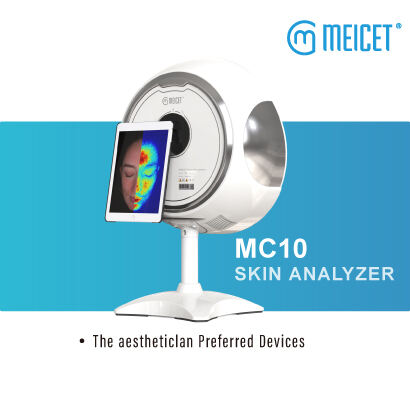
A lézeres kezelések – akár pigmentációra, akár texturaváltozásra, illetve öregedésgátlásra alkalmazzák őket – kontrollált bőrsérülést okoznak, amely gyógyulási és regenerációs folyamatot indít el. A siker attól függ, hogy ezt a gyógyulási folyamatot megfelelően monitorozzák a helyes felépülés biztosítása érdekében, az utókezelés szükség szerinti módosítása, valamint a következő kezelési ülések megtervezése érdekében. A hagyományos követéses vizsgálatok ambuláns látogatásokon alapulnak, ami a betegek számára terhes lehet, és késleltetheti a beavatkozást, ha problémák merülnek fel. A MEICET MC10-as hordozható bőranalizátora ezt a problémát orvosolja, mivel lehetővé teszi a többcsatornás képalkotást a mellékrendelőkben, így az orvosok a lézeres kezelés utáni gyógyulást ugyanolyan pontossággal nyomon követhetik, mint az ambuláns vizsgálatok során.
A gyógyulási folyamat nyomon követése
A lézeres kezelések megszakítják a bőr külső határfelületét, ezzel elindítva egy gyógyulási folyamat-sorozatot: gyulladás, epithelizáció (a felső réteg újraepithelizációja) és átépülés (kollagénszintézis). Az MC10 többcsatornás üzemmódjai minden szakaszt rögzítenek:
- RGB képalkotás a kráterek, hámlás és újrahámzás nyomon követésével figyeli az epithelialisodást. A leválasztó lézeres kezelések után az RGB skennelés megmutatja, hogy milyen gyorsan regenerálódik a bőr felső rétege – felhívva a késleltetett gyógyulásra a homlok (mely célzott hidratálást igényelhet) vagy túlzott kér szakadás (fertőzés kockázatának jele) esetén.
- Kereszt-polarizált fény (CPL) képalkotás az érfelhagyás észlelésével értékeli a gyulladást. Enyhe, helyi vörösség lézer után normális, de ha a CPL módban tartós, széleskörű dilatáció látható, ez túlzott gyulladásra utal – ekkor a hűtési protokollok módosítását vagy gyulladáscsökkentő külső szerek alkalmazását javasolják.
- UV képalkotás a pigmentváltozásokat követi nyomon, ami kritikus a lézeres pigmentcsökkentő kezeléseknél. A melasma vagy napfoltok esetén a UV szkennelés megmutatja, hogy a pigment egyenletesen halványodik-e vagy aktívabbá válik (túlkezelés vagy UV-expozíció jele), így segítve a folytatás vagy szünetelés döntésében.
Egy pattanóhegek kezelésére végzett frakcionált lézeres kezelés után az MC10 vizsgálatokat 1 héttel (RGB minimális hámlást és jó epitélizálódást mutat), 2 héttel (CPL a gyulladás visszaszorulását jelzi) és 1 hónap után (UV megerősíti, hogy nincs posztinflammatorás hiperpigmentáció) végezhetjük. Ez az idővonal megerősíti, hogy a gyógyulás rendben halad, így a klinikus biztonsággal tervezheti a következő kezelést.
A következő ellátás beállítása valós idejű adatok alapján
A lézeres kezelés utáni ápolás – hidratálók, napvédők és ingerlők kerülése – az egyéni gyógyulási válaszok alapján változhat. Az MC10 adatai lehetővé teszik az egyéni beállításokat:
- Egy lézeres kezelés után száraz, hámló bőrű beteg (RGB módban látható) számára gazdagabb hidratáló krém vagy fedő balm, nem a kezdetben javasolt könnyű emulzió szükséges.
- Valaki, akinek a bőre továbbra is piros (CPL folyamatban lévő értágulatot jelez), haszonnal vehet igénybe egy nyugtató szérumot zöld teafélével vagy niacinamiddel a rutinfeladatok között.
- A posztinflációs hiperpigmentációra hajlamos betegek (ami UV-vizsgálat során már korai pigmentaktivációként látható) számára megelőző világosító szereket lehet felírni, amelyeket az utókezelésbe ágyazhatnak be.
Ezek az alkalmazkodások nem csupán a kényelemről szólnak – hanem befolyásolják az eredmények hosszú távú minőségét. A megfelelő hidratáció támogatja a bőrbarrier helyreállását, csökkentve a fertőzés vagy hegesedés kockázatát, míg a célzott gyulladáscsökkentők minimalizálják az állásidőt és javítják a beteg elégedettséget.
További kezelések tervezése
A lézeres kezeléseket gyakran sorozatban végzik, az intervallumokat a gyógyulás és a válaszreakció határozza meg. Az MC10 adatai biztosítják, hogy a kezelések időzítése optimális legyen:
- Pigmentfoltkezelések esetén a UV-vizsgálatokon 30-50%-os pigmentcsökkenés azt jelzi, hogy a bőr már kész a következő kezelésre; minimális változás azt jelzi, hogy szükség lehet a lézeres beállítások módosítására (például magasabb fluencia) vagy hosszabb intervallum alkalmazására a teljes gyógyulás érdekében.
- A textúra-központú lézerekhez (például pattanásnyomok kezelésére) az RGB-szkennelések nyomon követik, hogyan javul a bőr simasága, és a következő kezelési üléseket akkor ütemezik be, amikor az epithelialisodás befejeződött és a gyulladásos folyamatok már rendeződtek – ezzel elkerülve a túlkezelést, ami súlyosbíthatná a hegképződést.
- Egy beteg, aki lézeres szőrtelenítésen esik át, MC10-szkennelésekkel ellenőrizheti a hajhagymák gyulladásos folyamatát (ez a jel azt mutatja, hogy a lézer megfelelően célozza a hajhagymákat), túlzott bőrkárosodás nélkül, így lehetővé téve a rendszeres időközönkénti kezelések ütemezését a legoptimálisabb szőrnövekedés-csökkentés érdekében.
Akadályok csökkentése az ellátás elérésében
Azoknál a betegeknél, akiknél mozgási korlátozottság, elfoglaltság vagy a fő rendelőtől való távoli lakhely miatt nehézséget jelent a rendelőbe való visszatérés, az MC10 hordozhatósága kiküszöböli ezt az akadályt, mivel lehetővé teszi a következő vizsgálatokat mellékrendelőkön, bőrgyógyászati outreach programokon vagy akár partner gyógyszertárakban – biztosítva ezzel a betegek kezelési tervhez való ragaszkodását.
Egy vidéki beteg például a helyi egészségházban végezhet MC10 vizsgálatokat lézeres kezelés után, ahol az adatokat digitálisan megosztják a fő rendelőben dolgozó bőrgyógyászattal. A bőrgyógyász átnézi a vizsgálatokat, jóváhagyja a következő kezelési ülést, és szükség esetén módosítja a gyógykezelést – mindezt anélkül, hogy a betegnek hosszú utat kellene tennie. Ez az elérhetőség javítja a kezelések befejezési arányát, és végül a kezelési eredményeket is.
Az MC10 Hordozható Bőranalizátor újraértelmezi a lézeres kezelés utáni ellátást, hiszen a pontosságon alapuló monitorozást hozzáférhetővé teszi a betegek számára, akárhol is tartózkodnak. A gyógyulás nyomon követésével, az utókezelés iránymutatásával és az ülések időzítésének optimalizálásával biztosítja, hogy a lézeres kezelések minden esetben megbízható, biztonságos eredményeket hozzanak – akár a fő rendelőben, akár egy mellékrendelőben történik a következő vizsgálat.
 EN
EN
 AR
AR
 BG
BG
 HR
HR
 CS
CS
 DA
DA
 NL
NL
 FI
FI
 FR
FR
 DE
DE
 EL
EL
 HI
HI
 IT
IT
 JA
JA
 KO
KO
 NO
NO
 PL
PL
 PT
PT
 RO
RO
 RU
RU
 ES
ES
 SV
SV
 TL
TL
 IW
IW
 ID
ID
 SR
SR
 SK
SK
 SL
SL
 UK
UK
 VI
VI
 SQ
SQ
 HU
HU
 TH
TH
 TR
TR
 FA
FA
 AF
AF
 MS
MS
 UR
UR
 BN
BN
 LA
LA

